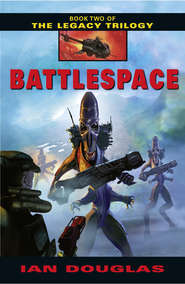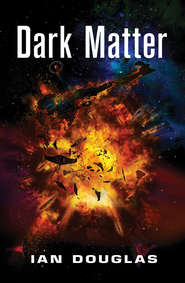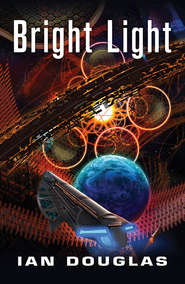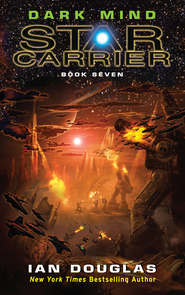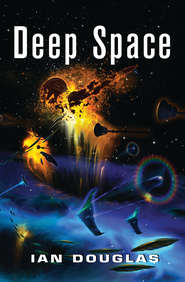По всем вопросам обращайтесь на: info@litportal.ru
(©) 2003-2024.
✖
Singularity
Настройки чтения
Размер шрифта
Высота строк
Поля
“Yeah. Except the scuttlebutt I heard was that the bugs know, and they’re leading us into a trap.”
“So, you’re believing scuttlebutt, now? Who told you that shit?”
“Uh … a gal I know in S-2.”
S-2 was the designation for America’s intelligence department. “Ah, well if Naval Intelligence said it, it must be true, right?”
He heard several chuckles over the squadron channel. Good. Loosen them up a bit. You don’t want them thinking too hard before a drop.
“We’ll be emerging far enough out-system that we’ll have plenty of time for a look around, okay? The entire Sh’daar galactic fleet could be in there, and they’d never even see us if we dropped in, took a look, and then jumped back into Alcubierre Space.” He hesitated, then grinned as he added, “Yes-no?”
That raised laughter from the waiting Dragonfires. The odd patterns of Agletsch speech and their constant use of the phrase “yes-no” was well known to everyone on board America by now.
“Sounds like we have an Agletsch loose in the squadron,” Rostenkowski said, laughing. “Since when did they start driving Dragonfires?”
“Dragonfires, PriFly,” Wizewski’s voice broke in. “Is there a problem?”
“Negative, CAG,” Gray replied. “No problem.”
“Can the chatter in there and focus on your finals. Emergence in three minutes. Drop in sixty seconds after that.”
“Aye, aye, sir.”
No sense of humor, that one.
He was glad the newbies in the squadron could laugh, though. They’d been training hard in sim, but the real deal was never like electronic simulations, no matter how bad-assed realistic the downloads.
If they could enjoy a joke now, they ought to be okay.
He hoped. …
CIC
TC/USNA CVS America
Outer System, Texaghu Resch System
112 light years from Earth
1103 hours, TFT
Emergence.
The star carrier America dropped into normal space as her Alcubierre bubble collapsed. Since she’d been motionless relative to the volume of space wrapped up inside the Alcubierre field, she emerged traveling at a velocity of only a few kilometers per second—the difference in relative velocities between this patch of space, and the space within the Kuiper Belt of HD 157950. The transition released a great deal of potential energy as light and hard radiation, a flaring burst spreading into and through the new star system at the speed of light.
Koenig studied the new system, both represented by icons within the tactical tank, and as revealed by optical sensors across the bulkhead viewalls of the Combat Information Center. They’d emerged ten astronomical units from the local star—a little farther than Saturn was from Sol. There were planets—five visible immediately, and there likely would be others as the ship’s navigational AIs scanned local space.
“Admiral?” a familiar voice asked. “This is CAG. So you still want to launch fighters?”
“Wait one,” Koenig told him. “We need to see what we’re launching to.”
Data continued to cascade in from the AIs scanning the system. Two inner rocky planets, small enough and close enough to their primary that they likely were too hot for Earth-type life. Planet III, 1.5 AUs from the star, was a small gas giant, about the size of Neptune. Beyond that, at 3 and 5 AUs, were two more rocky planets, both dazzlingly bright and probably encased pole to pole in planet-wide sheets of ice.
“Astrogation,” Koenig called. “Give that gas giant a close look. Maybe it has Earthlike moons.”
He was thinking of Alchameth, circling the star Arcturus, and its moon Jasper.
“We’ve been looking, Admiral. We’ve spotted several small moons—rocks, really—but nothing like a real planet.”
“Carry on, then.”
He felt a small bite of disappointment. Because of this system’s listing in the Turusch Directory, he’d assumed there would be an inhabited planet here—if not one with an oxygen-nitrogen atmosphere and temperate climes comfortable for humans, then one with the reducing atmosphere and hot, sulfur-laden conditions enjoyed by the Turusch.
The truth of the matter, though, was that habitable worlds of either type were painfully few and far between within that sliver of the galaxy explored so far by Humankind. The chances that a world of near-Earth mass would just happen to lie within the band of liquid-water temperatures around a star were slim; the fact that the Confederation had discovered as many as twenty where humans could walk unprotected—Chiron and Circe and Osiris and the others—spoke more to how many stars were out here, not to how common other Earths might be.
Texaghu Resch was a G2-type star almost identical to Sol … but it simply hadn’t won the planetological crapshoot that would have led to its possessing a planet humans could call home.
Something was flashing red in the tactical tank. Koenig looked … then blinked. There was something there. America’s instrumentation was picking up a gravitational anomaly. In essence, the ship was feeling about twice the force of gravity it should be feeling at this distance from a G-class star. It was exactly as though there were two stars in there—a close binary—each of about one solar mass … but one of the stars was invisible.
Either that, or the single visible star was twice as massive as it should be, and that simply wasn’t possible, not within the rules governing stellar classification as humans now understood them.
“Admiral?” another voice said. “This is Lieutenant Del Rey, in Astrogation.”
“Go ahead.”
“Have you seen the GA alert, sir?”
“Yes, I have. What do you make of it?”
“We didn’t know what the hell it was at first. We still don’t. But … take a look at this, sir.”
A visual feed came through, opening as a new window within Koenig’s in-head display. It appeared to be a highly magnified image of a portion of the star itself, with the light drastically stepped down by the AI controlling it. Koenig could see the curving limb of the star, the mottling of the surface granulation, the sweep and arch of stellar prominences. At first, he saw nothing out of the ordinary.
And then …
“Good God!” he said, expanding the image for a closer look. “What the hell is that?”
“We have no idea, sir,” Del Rey replied. “But we thought it might be important.”
And that, Koenig thought, was a hell of an understatement.
Chapter Six
29 June 2405
VFA-44
Outer System, Texaghu Resch System







